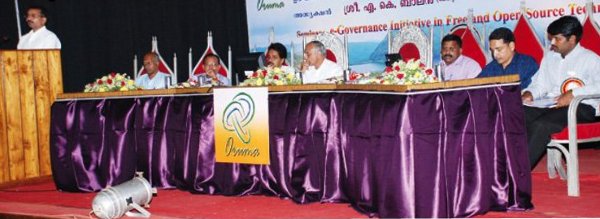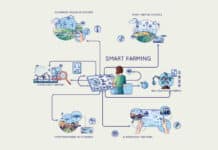
The KSEB was introduced to open source with the billing software Oruma in 2006, and it has not looked back ever since. Its implementation was soon followed by Saras, an accounting software used in expenditure accounting. As a result, KSEB has managed to save Rs 7-8 crore.
Open source in KSEB
KSEB is the statutory body engaged in the generation, transmission and distribution of electricity across the state. It deals with high tension (HT), extra high tension (EHT) and low tension (LT) current transmission to consumers. There are around eleven million LT consumers linked to KSEB, and they are billed through 697 electrical sections across the state, using Oruma. The solution provides for new connections, billing, cash collection and accounting of LT consumers.
“The software works in real-time, operates within a client-server architecture, and the database is distributed,” explains Sathyaraj J, joint director, IT at KSEB. “Data of 11 million consumers is stored in around 700 locations, and the data size in each location varies from a few hundred megabytes to 2 GB. The development strategy we follow here is to keep the database independent, as far as possible, so that the option of database portability is open. This way, database features are utilised at a minimum level.”
Each section has a server, and five to six client computers. PostgreSQL is used as a Relational Database Management System (RDBMS), Debian Linux as the server OS, Ubuntu Linux as the client OS, and PHP as the server-side scripting language for the Web-based frontend.
“Right from the beginning, we have been using community-supported open source products in the Oruma project. Oruma caters to new connections, billing, cash collection and accounting of LT consumers. The entire Oruma solution, including requirement gathering, systems analysis, design, coding, testing, piloting and end user training, was developed by an in-house team. This required training 15 employees (mainly, developers), on open source products. The only additional costs incurred were Rs 35,000 for staff training,” Sathyaraj says.
The accounting software Saras is also a real-time software deployed in a distributed architecture. It caters to expenditure accounting through the 140 account rendering units of KSEB. The client-server architecture used here is similar to that of Oruma, with the combination of PostgreSQL-Debian and Ubuntu-PHP. “We have invariably used the Apache Web servers in almost all applications, as they are deployed in a client-server architecture,” he claims.
Other open solutions developed in a centralised architecture are a Human Resource Management System (a centralised provident fund and payroll software developed in-house); HT and EHT billing software for new connections, billing, collection and accounting; software providing Web-enabled services like e-payment that was developed by TCS, and the Supply Chain Management System, which handles planning, procurement and store management, which was developed by Deloitte.
“The outsourced applications employ Java as the front end. CentOS, RHEL and JBoss are also used in the centralised applications. A new website launched by KSEB last year is also on an open source platform, using Joomla,” reveals Sathyaraj.
PostgreSQL — an essential element
For the last four years, KSEB has created over 840 databases across the state. Almost all its applications in major functional areas, operating either in a centralised or local architecture, use PostgreSQL. About 700 PostgreSQL databases have been used in the Oruma project, and over 4,000 employees of KSEB access these databases on a daily basis.
Saras has about 140 databases, which are used by about 1,000 users for daily transactions. Three projects under implementation (the Human Resource Information System or HRIS, the Supply Chain Management or SCM, and HT/EHT billing software) also use PostgreSQL databases. The HRIS will have a single database, and over 500 users are expected to use it on a daily basis. The SCM system uses PostgreSQL, and about 1,000 users are expected to access this centralised database for daily transactions. And about 30 people will use the HT/EHT billing software, every day.
Earlier, KSEB used Microsoft’s SQL Server 2000 for its database. As per the recommendations of the Committee for Information and Communication Technology (ICT) constituted by the KSEB, the board decided to select an RDBMS package based on Free Software packages, to computerise the major functional areas in KSEB.
Sathyaraj reveals, “The committee also evaluated MySQL and Oracle databases in comparison with PostgreSQL. We chose PostgreSQL because of its capacity to handle huge volumes of data, and its ability to read and write data at almost equal speed. All the projects we have used PostgreSQL for are mission-critical — and so far, we have been satisfied with the results.”
The challenges faced
In the beginning, KSEB faced challenges at every point, from the availability of trained manpower to the dearth of experts who have hands-on experience in handling critical data on PostgreSQL. “However, we managed well, because of the whole-hearted support of the local, as well as global, open source community, and were victorious at the end,” Sathyaraj admits.
One of the main problem areas was porting data from MS SQL Server 2000 to PostgreSQL. “We were new to PostgreSQL. Correcting, updating and porting the data of around 10 million consumers, back then, necessitated developing a new data-entry software on PostgreSQL, and a migration software to port data from SQL Server 2000, before final migration to the Oruma database. Now, the details of new consumers can be added to the Oruma database in real time, using the software,” Sathyaraj says.
Advantages over proprietary solutions
The economic and technical superiority of FOSS over proprietary software paved the way for its selection in KSEB. The board has saved about Rs 7-8 crore by implementing open source tools for deployment of various applications. Sathyaraj reveals, “The use of proprietary software tools invites recurring expenditure in terms of licence renewals and version updation, which calls for huge additional expenditure. The government has become aware about this recurring expenditure, and supports open source solutions to the maximum extent possible to keep IT expenses down to the minimum. The use of open source solutions also relieves government agencies from vendor dependability to a great extent.”
Another important advantage of open source is that the code is with you. “If there is a problem in the code, and you are capable of understanding and modifying it, you can do it without any legal complications. Moreover, let’s not forget the online community, which helps you to any extent. In terms of scalability, PostgreSQL stands at par with industry-known proprietary databases like SQL Server, and other open source solutions like MySQL,” he asserts.
Additional investments
KSEB uses community-supported versions of PostgreSQL in all in-house applications, and so there is no cost component involved. For outsourced applications, there is a cost involved in the form of service support, which can run into a few lakhs, and varies according to the project. Additional investment is required in the form of training. Currently, around 100 employees working at various levels, from developers to systems administrators and systems supervisors, are given periodic training to upgrade their skills in open source.
KSEB uses high-end PCs and servers with an Intel Core i3-560, 3.3 GHz processor or AMD Phenom II X4 955, 3.2 GHz processor, 4 GB DDR3 RAM, 320 GB SATA 3GBps HDDs for Saras and Oruma. The utility company purchased new computers, as earlier, operations and systems were entirely manual.There are around 840 such servers now, operating at various locations. Each high-end PC costs around Rs 40,000. Similar machines are used as servers, for the centralised HRIS project too.
Meanwhile, for the HT/EHT billing system, and for the SCM system, rack-mounted high-end servers with Intel Xeon E5540 Quad core processors, 12 GB DDR3 RAM, 2 x146 GB, and 15K SAS hot plug hard disks are being used to host the database and applications.
Open source in the government sector
When asked whether he would recommend open source to others in the government sector, Sathyaraj’s response is: “Why not?” In fact, the National IT Policy and the draft Kerala State IT Policy released recently promote the use of open source as solutions with less investment.
“The electrical industry is capital-intensive and requires a huge investment, and utilities are looking for financially viable alternatives for IT implementation. By harmonising the existing human potential of organisations with the available resources, the investment for IT implementation can be brought down. The success of project Oruma and other open source solution implementations in KSEB proves this beyond doubt,” Sathyaraj concludes.
















































































Really glad to view this post. It’s not only just a cost-cutting initiative from KSEB, but a big time example setter to other government organizations in migrating their existing proprietary infrastructure to FOSS alternatives.
One correction though.. Its stated, “industry-known proprietary databases like SQL Server, Oracle and MySQL,” Sathyaraj asserts”.. Unlike SQL Server or Oracle, MySQL is a totally Open Source Powered Database Server.